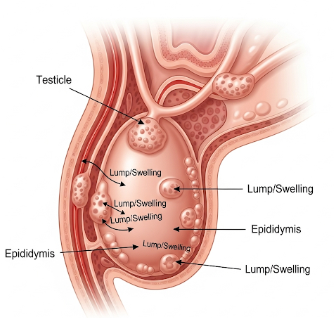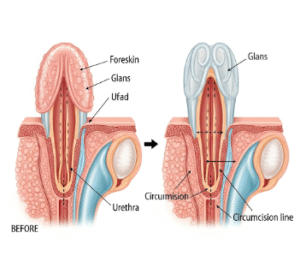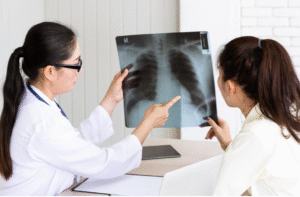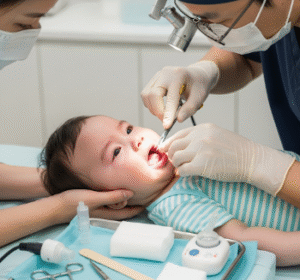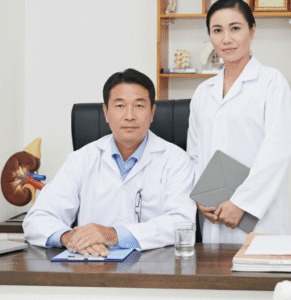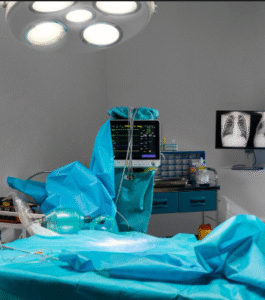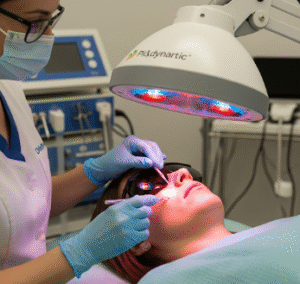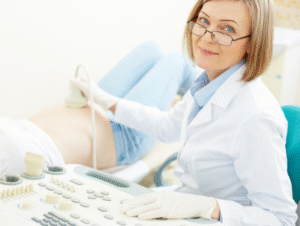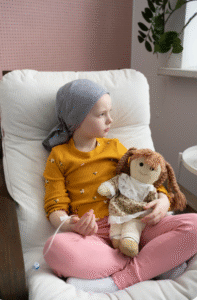➤ Overview
Testicle lumps and swellings refer to abnormal growths or enlargement of one or both testicles, which can range from benign cysts to serious conditions like testicular cancer. Men may notice pain, heaviness, or asymmetry in the scrotum. Early recognition is critical, as timely diagnosis can prevent complications and improve treatment outcomes.
In South Korea, evaluation is conducted by urologists and andrologists using physical examination, ultrasound, and laboratory tests. Advanced imaging and surgical techniques ensure accurate diagnosis and effective treatment.
➤ Key Facts
→ Testicular lumps may be painful or painless, with painless lumps often requiring more urgent evaluation.
→ Common causes include cysts, infections, varicocele, hydrocele, trauma, or tumors.
→ Testicular cancer is most common in men aged 15–35, but can occur at any age.
→ In Korea, ultrasound and tumor marker tests are standard for evaluation.
→ Early detection improves prognosis and allows less invasive treatment.
→ Swelling may be acute (sudden) or chronic (gradual).
→ Symptoms may affect fertility, sexual health, and overall quality of life.
➤ What is Testicle Lumps and Swellings?
Testicular lumps and swellings represent structural or functional changes in the testes or scrotum:
→ Localized lump – Firm or soft mass in the testicle.
→ Diffuse swelling – Enlargement of the entire testicle or scrotum.
→ Consistency – Lumps may feel hard, smooth, or cystic.
→ Mobility – Some lumps are mobile, others fixed, which helps differentiate causes.
→ Associated scrotal changes – Redness, warmth, or fluid accumulation.
→ Indicator of underlying pathology – Could be benign, infectious, traumatic, or malignant.
➤ What Symptoms are Related to Testicle Lumps and Swellings?
Symptoms vary based on underlying cause:
→ Painless lump → Often seen in testicular tumors.
→ Pain or tenderness → May indicate infection, inflammation, or trauma.
→ Swelling or heaviness → Feeling of fullness or pressure in the scrotum.
→ Redness or warmth → Signs of infection such as epididymitis or orchitis.
→ Hydrocele → Fluid accumulation around the testicle causing swelling.
→ Varicocele → Enlarged veins in the scrotum, often felt as a “bag of worms.”
→ Changes in testicle size or shape → Asymmetry may indicate pathology.
→ Systemic symptoms – Fever, nausea, or malaise in infections.
➤ What Causes / Possible Causes?
Testicle lumps and swellings can arise from benign, infectious, traumatic, or malignant causes:
→ Epididymal cysts (spermatocele) → Fluid-filled sacs in the epididymis.
→ Hydrocele → Accumulation of fluid around the testicle.
→ Varicocele → Enlarged veins in the scrotum, often left-sided.
→ Infections → Epididymitis, orchitis, or sexually transmitted infections.
→ Trauma or injury → Contusion, hematoma, or rupture of testicular tissue.
→ Testicular cancer → Seminomas, non-seminomas, or mixed germ cell tumors.
→ Hernias → Indirect inguinal hernia may cause scrotal swelling.
→ Systemic conditions → Heart, liver, or kidney disease causing fluid retention.
→ Idiopathic → Some swellings may have no identifiable cause initially.
➤ When Should I See My Doctor?
Immediate medical evaluation is crucial if any of the following occur:
→ A new, painless lump → Could indicate testicular cancer.
→ Rapidly enlarging or painful swelling → Infection, torsion, or trauma.
→ Redness, warmth, or fever → Suggests infection requiring urgent care.
→ Changes in size or shape → Any asymmetry should be investigated.
→ Trauma with severe pain or bruising → Rule out testicular rupture.
→ Systemic symptoms – Nausea, vomiting, or malaise with swelling.
→ In Korea, urologists use ultrasound, lab tests, and tumor markers for rapid, accurate evaluation.
➤ Care and Treatment
Management depends on cause, severity, and risk factors:
→ Observation – Small, asymptomatic cysts may only require monitoring.
→ Antibiotics – Treat bacterial infections such as epididymitis.
→ Pain relief – NSAIDs for discomfort and inflammation.
→ Surgical intervention – Hydrocelectomy, varicocelectomy, or excision of cysts or tumors.
→ Testicular cancer treatment – Orchiectomy followed by chemotherapy or radiotherapy if indicated.
→ Supportive measures – Scrotal elevation, ice packs, and avoidance of strenuous activity.
→ Fertility considerations – Semen analysis and sperm banking before surgery if needed.
→ Regular follow-up – Monitor for recurrence, complications, or treatment response.
➤ Treatment Options in Korea
South Korea offers advanced diagnostic and treatment services for testicular lumps and swellings:
Diagnosis in Korea
→ Scrotal ultrasound – First-line imaging to differentiate cysts, tumors, and fluid collections.
→ Blood tests and tumor markers – AFP, β-hCG, and LDH for suspected malignancy.
→ Urine and STI testing – Identify infections contributing to swelling.
→ Physical examination by urologists – Assess consistency, mobility, and associated findings.
→ Advanced imaging – CT or MRI for staging cancer or complex cases.
Medical Treatments in Korea
→ Antibiotics – For bacterial infections like epididymitis or orchitis.
→ Pain management – NSAIDs or acetaminophen for symptom relief.
→ Observation programs – Monitor benign cysts and minor swellings.
Surgical and Advanced Therapies in Korea
→ Hydrocelectomy – Removal of fluid-filled sacs.
→ Varicocelectomy – Surgical repair of enlarged veins.
→ Orchiectomy – Partial or total removal of testicle in malignancy cases.
→ Fertility preservation programs – Sperm banking prior to surgery.
→ Multidisciplinary care – Collaboration between urology, oncology, and reproductive specialists.
Rehabilitation & Support in Korea
→ Post-surgery monitoring for recurrence or complications.
→ Guidance on fertility, sexual health, and lifestyle adjustments.
→ Patient education programs on early detection, self-examination, and preventive measures.

